
|
|
| ||||||||||||||||||||||||||||||||||||||||||||||||||||||||||||||||||||||||||||||||||||||||||||||||||||||||||||||||||||||||||||||||||||||||||||||||||||||||||||||||||||||||||||||||||||||||||||||||||||||||||||||||
DIXIE CLASS DESTROYER TENDERS (AD) |
||||
Name of Ship |
Hull No. |
Builder |
Launched |
Stricken Date |
DIXIE |
14 |
New York Ship Building; Camden New Jersey |
27 May 1939 |
15 June 1982 |
PRAIRIE |
15 |
New York Ship Building; Camden New Jersey |
09 Dec. 1939 |
26 March 1993 |
PIEDMONT |
17 |
Tampa Shipbuilding Co, Tampa Florida |
07 Dec. 1942 |
06 Aug. 1987 |
SIERRA |
18 |
Tampa Shipbuilding Co, Tampa Florida |
23 Feb. 1943 |
15 Oct. 1993 |
YOSEMITE |
19 |
Tampa Shipbuilding Co, Tampa Florida |
16 May 1943 |
27 Jan. 1994 |
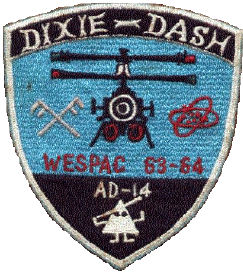
DIXIE CLASS DESTROYER TENDERS POST-FRAM SPECIFICATIONS |
|
Displacement: |
11,343 tons standard (17,693 tons full load) |
Dimensions: |
530' 6" x 73' 4" beam x 25' 6" maximum draft |
Guns: |
2 qty, TWIN 5 inch/38 caliber MK 12 mod 1 guns installed on MK 38 gun mount and 4 qty, 40 mm gun mounts.NOTE: During FRAM, 2 AFT TWIN 5 inch/38 caliber MK 12 mod 1 guns REMOVED as well as eight quantity, 40 mm guns resulting in above remaining equipment. |
Machinery: |
2 Babcock turbines coupled to Parsons locked-train double reduction gears. 2 shafts, SHP: 11,000 = 19.6 knots |
Boilers: |
FOUR Babcock & Wilcox; working pressure 565 PSI at 850 degrees F |
Complement: |
Allowance: 983 enlisted and 49 officers (Sierra was 886 and 37, Yosemite was 994 and 55, respectfully). The other tenders varied in their complement but was close to these ratios. Total accommodations averaged 1,698. |
![]()
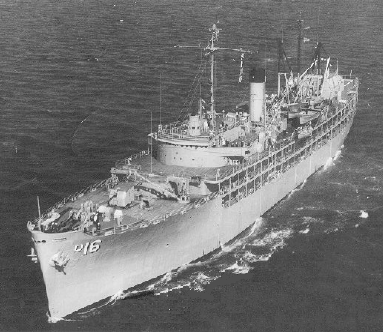 The Cascade Class of Destroyer Tender consisted on a single
vessel; the USS CASCADE (AD-16). Built
by Western Pipe and Steel Company of San Francisco and launched on 6 June 1942,
the CASCADE was commissioned on 12 March 1943. After being decommissioned after
World War II on 12 February 1951, CASCADE was recommissioned 5 April 1951 and
served as a DASH maintenance and overhaul ship upon its FRAM in 1963 which
installed the DASH shop, hangar and aft flight deck. CASCADE served until being decommissioned
on 22 November 1974 and struck from the Naval register the following day.
CASCADE was sold for scrapping on 1 October 1975.
The Cascade Class of Destroyer Tender consisted on a single
vessel; the USS CASCADE (AD-16). Built
by Western Pipe and Steel Company of San Francisco and launched on 6 June 1942,
the CASCADE was commissioned on 12 March 1943. After being decommissioned after
World War II on 12 February 1951, CASCADE was recommissioned 5 April 1951 and
served as a DASH maintenance and overhaul ship upon its FRAM in 1963 which
installed the DASH shop, hangar and aft flight deck. CASCADE served until being decommissioned
on 22 November 1974 and struck from the Naval register the following day.
CASCADE was sold for scrapping on 1 October 1975.
CASCADE CLASS DESTROYER TENDER POST-FRAM SPECIFICATIONS |
|
Displacement: |
9,800 tons standard (16,600 tons full load) |
Dimensions: |
492' x 69' 6" beam x 27' 3" maximum draft |
Guns: |
2 qty, TWIN 5 inch/38 caliber MK 12 mod 1 guns installed on MK 38 gun mount and 6 qty, 40 mm anti-aircraft gun mounts.NOTE: During FRAM, 1 AFT TWIN 5 inch/38 caliber MK 12 mod 1 guns REMOVED resulting in above remaining equipment. |
Machinery: |
Babcock turbine coupled to Parsons locked-train double reduction gears. 1 shaft, SHP: 8,500 = 18.4 knots |
Boilers: |
Two Babcock & Wilcox; working pressure 565 PSI at 850 degrees F |
Complement: |
Allowance: 857 Total Accommodation |
![]()
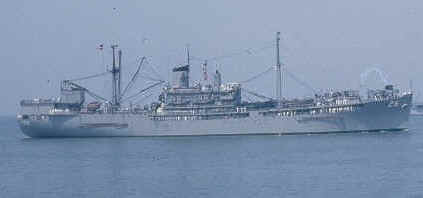 With the reclassification of the Tender KLONDIKE as a
Repair Ship on 20 February 1960 resulting in the hull number AR-22, the lowest
hulled Tender of this class was ARCADIA (AD-23) and thus the ARCADIA Class of
Destroyer Tenders. USS SHENANDOAH is seen at
left.
With the reclassification of the Tender KLONDIKE as a
Repair Ship on 20 February 1960 resulting in the hull number AR-22, the lowest
hulled Tender of this class was ARCADIA (AD-23) and thus the ARCADIA Class of
Destroyer Tenders. USS SHENANDOAH is seen at
left.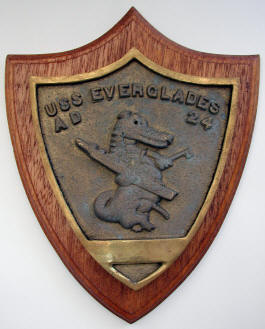
ARCADIA CLASS DESTROYER TENDERS (AD) |
||||
Name of Ship |
Hull No. |
Builder |
Launched |
Stricken Date |
ARCADIA |
23 |
Todd-Pacific Shipyards Inc, of San Pedro, CA |
19 Nov. 1944 |
01 July 1973 |
EVERGLADES |
24 |
Los Angeles Ship Building and Dry Dock Co., L.A., CA |
28 Jan. 1945 |
24 May 1989 |
FRONTIER |
25 |
Los Angeles Ship Building and Dry Dock Co., L.A., CA |
25 Mar. 1945 |
01 Dec. 1972 |
.gif)
ARCADIA CLASS DESTROYER TENDER POST-FRAM SPECIFICATIONS |
|
Displacement: |
8,165 tons standard (16,635 to 16,900 tons full load) |
Dimensions: |
465' x 69' 6" beam x 27' 2" maximum draft |
Guns: |
1 qty, SINGLE 5 inch/38 caliber MK 12 mod 1 guns, 4 qty, 40 mm anti-aircraft gun mounts and 4 qty, 3 inch/50 caliber semiautomatic gun on a MK 34 gun mount.NOTE: During FRAM, 1 AFT SINGLE 5 inch/38 caliber MK 12 mod 1 gun, 4 of the 40mm and all 12 of the 20 mm guns were REMOVED resulting in above remaining equipment. Please note: All ships differed in their final weapons arrangement as FRAM overhaul was not the same for all ships. |
Machinery: |
Babcock / Westinghouse turbine coupled to Parsons / De Laval locked-train double reduction gears. 1 shaft, SHP: 8,500 = 18.4 knots |
Boilers: |
Two Foster-Wheeler OR Babcock & Wilcox; working pressure 565 PSI at 850 degrees F |
Complement: |
Allowance: 778 to 918 Total Accommodation |
![]()

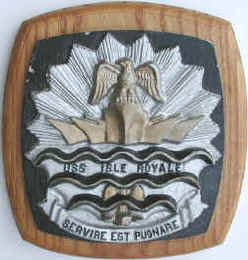
SHENANDOAH CLASS DESTROYER TENDERS (AD) |
||||
Name of Ship |
Hull No. |
Builder |
Launched |
Stricken Date |
SHENANDOAH |
26 |
Todd-Pacific Shipyards Inc, of Tacoma, WA |
29 Mar. 1945 |
01 Apr. 1980 |
YELLOWSTONE |
27 |
Todd-Pacific Shipyards Inc, of Tacoma, WA |
12 Apr. 1945 |
12 Sept. 1974 |
GRAND CANYON |
28 |
Todd-Pacific Shipyards Inc, of Tacoma, WA |
27 Apr. 1945 |
01 Sep. 1978 |
ISLE ROYALE |
29 |
Todd-Pacific Shipyards Inc, of Seattle, WA |
19 Sep. 1945 |
15 Sep. 1976 |
TIDEWATER |
31 |
Charleston Navy Yard, Charleston, SC |
30 June 1945 |
15 June 1978 |
BRYCE CANYON |
36 |
Charleston Navy Yard, Charleston, SC |
07 Mar. 1946 |
30 June 1981 |
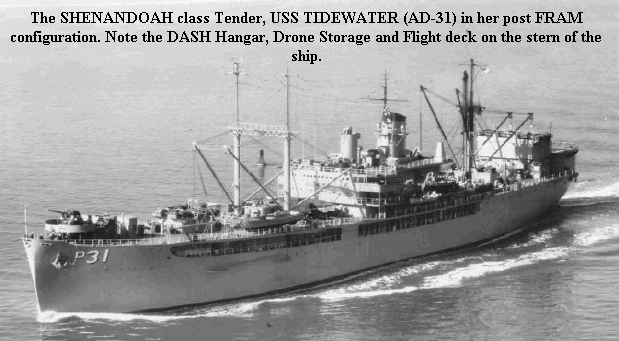
SHENANDOAH CLASS DESTROYER TENDER POST-FRAM SPECIFICATIONS |
|
Displacement: |
11,755 tons standard (16,880 tons full load) |
Dimensions: |
492' x 69' 6" beam x 28' maximum draft |
Guns: |
2 qty, SINGLE 5 inch/38 caliber MK 12 mod 1 guns, 8 qty, 40 mm anti-aircraft gun mounts and 22 qty, 20mm guns.NOTE: During FRAM, 1 AFT SINGLE 5 inch/38 caliber MK 12 mod 1 gun, 4
of the 40mm and ALL of the 20 mm guns were REMOVED with the addition
of four, 3"/50 caliber guns resulting in:
|
Machinery: |
Babcock / Westinghouse turbine coupled to Parsons / De Laval locked-train double reduction gears. 1 shaft, SHP: 8,500 = 18.4 knots |
Boilers: |
Two Foster-Wheeler OR Babcock & Wilcox; working pressure 565 PSI at 850 degrees F |
Complement: |
Allowance: 778 to 918 Total Accommodation |
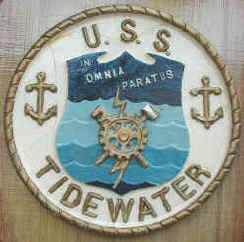
![]()
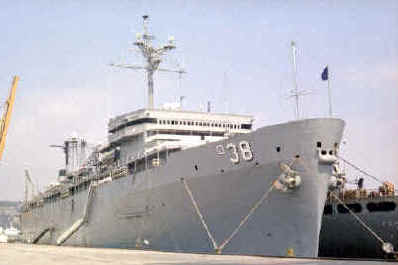 Authorized in FY 1965 at a cost of $ 37 million each, the SAMUEL GOMPERS class of two destroyer
tenders were the first built from a post World War II design. Designed
with the FRAM improvements installed on the previous 3 classes of ADs to have repair,
supply and support facilities on-board for not only the currently in-use ASROC
and DASH systems, but also the improved missile systems soon to be deployed, we
mentioned these two Destroyer Tenders as they were DASH support ships while not
part of FRAM.
Authorized in FY 1965 at a cost of $ 37 million each, the SAMUEL GOMPERS class of two destroyer
tenders were the first built from a post World War II design. Designed
with the FRAM improvements installed on the previous 3 classes of ADs to have repair,
supply and support facilities on-board for not only the currently in-use ASROC
and DASH systems, but also the improved missile systems soon to be deployed, we
mentioned these two Destroyer Tenders as they were DASH support ships while not
part of FRAM.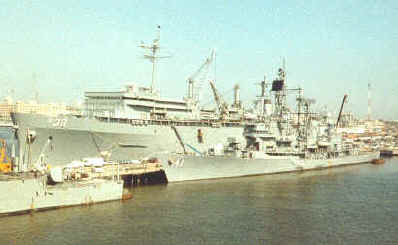 having shops to repair electronics, ASW weapons, and
advanced communications, this class also had the capability to repair nuclear propulsion
plants and had the equipment to allow for such work, including two 30-ton
kingpost cranes along with two 6-ton traveling cranes. Each was equipped with
DASH Hangar, drone storage and flight decks. Each tender of this class operated
in its own theatre; SAMUEL GOMPERS in WestPac (Western Pacific), with her home
port at San Diego and PUGET SOUND
in LANTFLT (Atlantic Fleet) with her home port at Newport, R.I.
having shops to repair electronics, ASW weapons, and
advanced communications, this class also had the capability to repair nuclear propulsion
plants and had the equipment to allow for such work, including two 30-ton
kingpost cranes along with two 6-ton traveling cranes. Each was equipped with
DASH Hangar, drone storage and flight decks. Each tender of this class operated
in its own theatre; SAMUEL GOMPERS in WestPac (Western Pacific), with her home
port at San Diego and PUGET SOUND
in LANTFLT (Atlantic Fleet) with her home port at Newport, R.I.
SAMUEL GOMPERS CLASS DESTROYER TENDERS (AD) |
||||
Name of Ship |
Hull No. |
Builder |
Launched |
Stricken Date |
SAMUEL GOMPERS |
37 |
Puget Sound Naval Shipyard, Bremerton, WA |
14 May 1966 |
07 Apr. 1999 |
PUGET SOUND |
38 |
Puget Sound Naval Shipyard, Bremerton, WA |
16 Sept. 1966 |
Laid up-Cat B at Philadelphia Naval Shipyard |
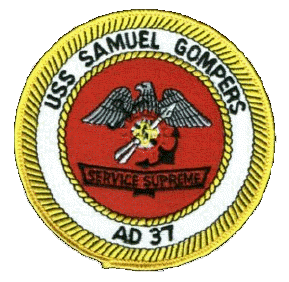
SAMUEL GOMPERS CLASS DESTROYER TENDERS (AD)
|
|||
Name of Ship |
Hull No. |
Status |
Berth |
SAMUEL GOMPERS |
37 |
Stricken; sunk on July 22, 2003 (SINKEX) |
Sunk off the Atlantic Coast by the USS COLE (DDG-67) |
PUGET SOUND |
38 |
Inactive, Out of Commission, in reserve |
NAVSEA Inactive Ships On-site Maintenance Office, Philadelphia, PA |
SAMUEL GOMPERS CLASS DESTROYER TENDER SPECIFICATIONS (AD) |
|
Displacement: |
14,156 tons light (20,830 tons full load) |
Dimensions: |
645' x 85' beam x 30' maximum draft |
Radar |
Raytheon SPS-64(V)9 for navigation; 1 Raytheon SPS-10 surface search TACAN: AD-38 only- Model URN-25 |
Guns: |
1 qty, SINGLE 5 inch/38 caliber MK 12 mod 1 guns. The 5" gun on AD-38 was eventually replaced with a 127 mm dual purpose gun. In 1979, that gun installation was then removed. Plans to install SEA SPARROW missile system forward of the bridge was abandoned. |
Machinery: |
2 sets of DeLaval locked-train double reduction gears. 1 shaft, SHP: 20,000 = 18 knots |
Boilers: |
Two Babcock & Wilcox; working pressure 620 PSI at 865 degrees F |
Complement: |
Allowance- AD 37: 136 Officers 1671 EnlistedAllowance- AD 38: 106 Officers 1314 Enlisted |
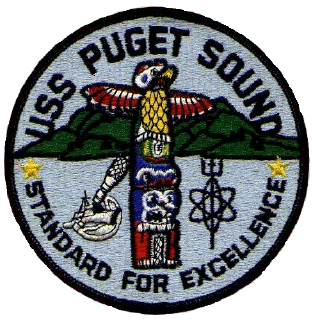
![]()
![]()
|
The name "Gyrodyne" in its stylized
form above, is the Trademark of and owned by the Gyrodyne Helicopter Historical
Foundation; unauthorized use is PROHIBITED by Federal Law. All Photographs, technical specifications, and
content are herein copyrighted and owned exclusively by Gyrodyne Helicopter
Historical Foundation, unless otherwise stated. All Rights Reserved
©2013. |